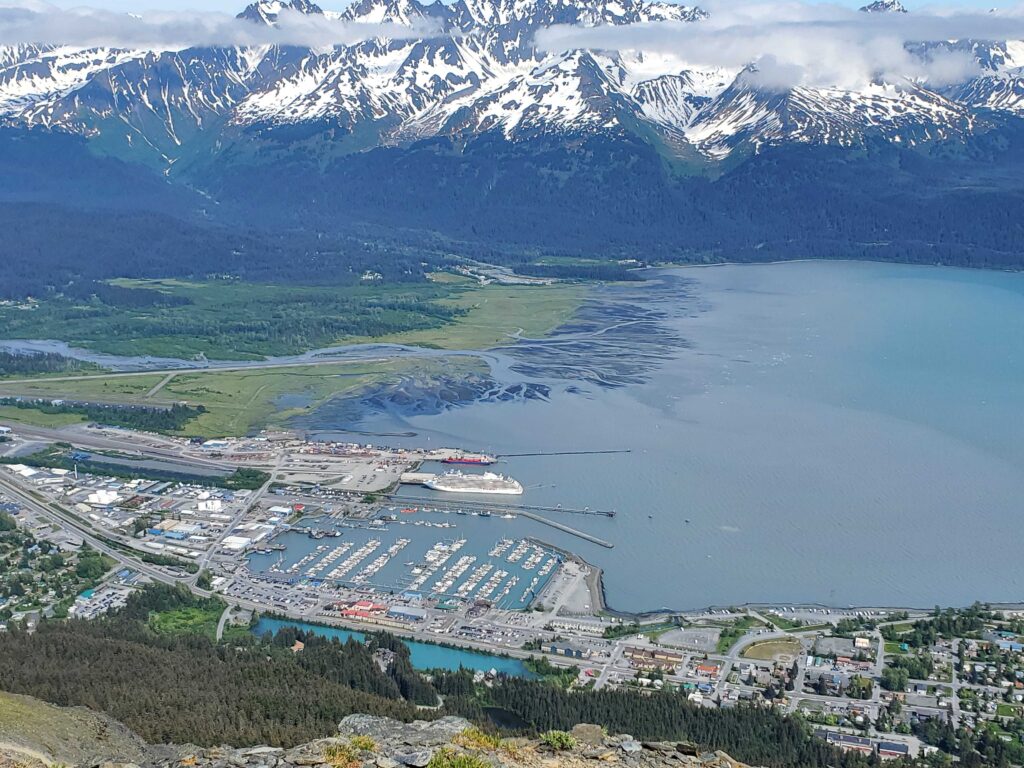![]()
A docked cruise ship, the Regent Seven Seas Explorer, is seen in Seward’s harbor on June 19 from the Race Point on Mount Marathon. The Port of Seward received a Clean Ports Program grant from the Environmental Protection Agency for a shore-based system to power cruise ships when they are docked in town. (Photo by Yereth Rosen/Alaska Beacon)
The Port of Seward, which serves a coastal Kenai Peninsula town that is a tourism hotspot in the summer, has received a $45.7 million grant to develop a system to cut air pollution from visiting cruise ships.
The grant, from the Environmental Protection Agency’s Clean Ports Program, is for shore-based power and battery storage systems to be used by the cruise ships that sail in and out of Seward. Those systems will allow cruise ships to switch to electric power from the emissions-spewing diesel fuel they burn while making port calls.
The systems are planned as part of a redeveloped cruise facility expected to be operating in 2026. The new facility is designed to have a floating pier to replace the current fixed dock, accommodating more and bigger ships.
The port project is led by The Seward Company, a public-private developer with the Alaska Railroad, Royal Caribbean Group and Turnagain Marine as partners.
The EPA Clean Ports grant will help Seward meet its environmental goals, the city’s mayor said in a statement.
“The Port of Seward’s shore power project will place Seward among the forefront of sustainable ports in North America. By reducing reliance on diesel generators, we are not only cutting emissions but also enhancing the resilience of our local electric grid,” Mayor Sue McClure said in the statement.
Seward is the smallest community among those with ports that received the 55 EPA Clean Ports Program grants announced last week.
Most of the grant-receiving ports are in major population centers. The three biggest grants went to the Port of Los Angeles, the Port of Virginia in Norfolk and the Port of New York and New Jersey. The Port of Alaska in Anchorage, the state’s largest city, was another grant recipient, getting $1.9 million for an emissions inventory and clean-energy transition study.
Seward, in contrast, has only about 2,500 full-time residents within city limits and a roughly similar number in areas just outside of the city boundaries, said Kat Sorensen, the city manager.
But in summer, Seward’s numbers swell. Seasonal workers bring the population to about 7,500 to 10,000, Sorensen said, and tourists add several thousands more each day, she said.
Cruise travel has grown in Seward, just as it has grown in the state in general, Sorensen said.
Alaska’s cruise business has hit all-time highs, bouncing back from the halt caused by the COVID-19 pandemic. In 2023, a record 1.65 million cruise passengers visited the state, and this year’s totals could wind up being even higher, according to industry reports.
While most cruise passengers’ travel in Alaska is in Southeast Alaska, Seward — in the state’s Southcentral region — got about 190,000 cruise passengers last year, according to industry experts. Between April and October of this year, there were 104 scheduled cruise ship stops in Seward, according to the Cruise Lines International Association.
Sorensen said the cruise companies need to keep their ships powered when making port calls in Seward.
“A fishing boat can come in for a week and just shut off. But the cruise ships can’t,” she said.
Along with building onshore power and battery storage systems, the plan includes a workforce-development program focused on the Seward-based Alaska Vocational Technical Center, she said.
“I think it’s just a win-win-win,” she said.
Alaska’s capital city, Juneau, was the first to develop a shore-based power system for cruise ships. While Seward is on track to be the second Alaska cruise destination to develop such a system, shore-based power is now available for cruise ships in several major ports along the U.S. West Coast and around the world.

GET THE MORNING HEADLINES.

